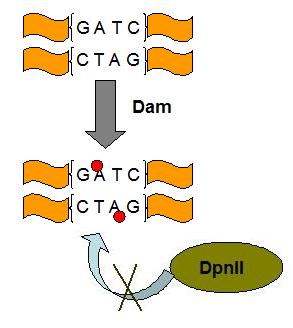Team:Imperial College London/M3/DamMethylation
From 2009.igem.org
(→Dam methylation) |
(→Dam methylation) |
||
| Line 6: | Line 6: | ||
Restriction enzymes often come together with methylation enzymes to form a restriction-modification system. This well-known combination prevents the genome of the cell from being cleaved by its own restriction enzyme. <br> | Restriction enzymes often come together with methylation enzymes to form a restriction-modification system. This well-known combination prevents the genome of the cell from being cleaved by its own restriction enzyme. <br> | ||
<br> | <br> | ||
| - | In our system, to protect against DNA destruction due to basal levels of restriction enzyme production, we have made use of the native E. coli Dam methylase protection system. | + | Methylation as a protection device against resriction enzymes is well documented, and has been proven to work. There is a strong asymmetry between the function of restriction enzymes and methylases. Restriction enzymes can cause just one cleavage, which if unrepaired, kills the cell. However, to effectively protect the cell, methylases need to methylate all the recognition sites. Endogenous promoters are preferred in this case as the fine balance that exists naturally between rstriction enzymes and methylases can be easily disrupted. <br> |
| - | + | <br> | |
| - | + | In our system, to protect against DNA destruction due to basal levels of restriction enzyme production, we have made use of the native E. coli Dam methylase protection system. The Dam system is chosen as both DpnII and TaqI enzyme activity can be blocked by Dam methylation.<br> | |
| + | <br> | ||
Dam methylases recognise the sequence GATC and methylate the Adenine base. This prevents the restriction enzymes from recognising the sequence and cleaving it. Therefore, only high levels of restriction enzyme (ie. after thermal triggering) will cleave the DNA. <br> | Dam methylases recognise the sequence GATC and methylate the Adenine base. This prevents the restriction enzymes from recognising the sequence and cleaving it. Therefore, only high levels of restriction enzyme (ie. after thermal triggering) will cleave the DNA. <br> | ||
| - | |||
| - | |||
<br> | <br> | ||
| - | |||
<!-- | <!-- | ||
Revision as of 23:19, 11 October 2009

Contents[hide] |
 Module 3: Genome Deletion Overview
Module 3: Genome Deletion Overview
Dam methylation
Restriction enzymes often come together with methylation enzymes to form a restriction-modification system. This well-known combination prevents the genome of the cell from being cleaved by its own restriction enzyme.
Methylation as a protection device against resriction enzymes is well documented, and has been proven to work. There is a strong asymmetry between the function of restriction enzymes and methylases. Restriction enzymes can cause just one cleavage, which if unrepaired, kills the cell. However, to effectively protect the cell, methylases need to methylate all the recognition sites. Endogenous promoters are preferred in this case as the fine balance that exists naturally between rstriction enzymes and methylases can be easily disrupted.
In our system, to protect against DNA destruction due to basal levels of restriction enzyme production, we have made use of the native E. coli Dam methylase protection system. The Dam system is chosen as both DpnII and TaqI enzyme activity can be blocked by Dam methylation.
Dam methylases recognise the sequence GATC and methylate the Adenine base. This prevents the restriction enzymes from recognising the sequence and cleaving it. Therefore, only high levels of restriction enzyme (ie. after thermal triggering) will cleave the DNA.
References
Module 3 - Genome Deletion






 "
"
 Home
Home Module 1: Protein Production
Module 1: Protein Production Module 2: Encapsulation
Module 2: Encapsulation Module 3: Genome Deletion
Module 3: Genome Deletion Module integration
Module integration Wet Lab
Wet Lab Dry Lab
Dry Lab Human Practices Project
Human Practices Project Notebook
Notebook



